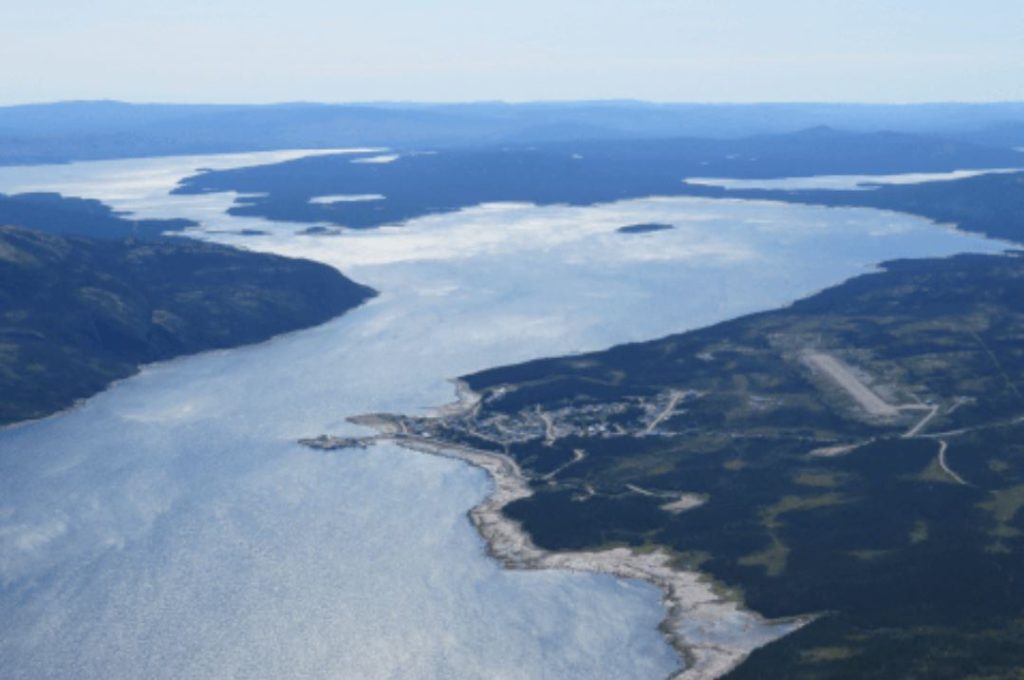Labrador Uranium drills 0.31% U3O8 over 0.5 metres at CMB, Labrador

Labrador Uranium Inc. [LUR-CSE; LURAF-OTCQB] reported assay results from the 2022 exploration program in the Central Mineral Belt (CMB) property in central Labrador, Canada. The CMB Project is 100%-owned and operated by LUR. A total of 2,194.2 metres were drilled.
Highlights: The overall goal of the 2022 drill campaign was to test various structural components along the Moran Lake Trend which were identified to have the potential to expand known mineralization.
Hole ML-200 tested the southwestern end of the northwest-trending Moran Lake C Zone which lies within a complex structural corridor bound by two major parallel structures. Shears and faults in ML-200 revealed a downdip continuation and increasing grade of mineralization from historical drillholes ML-191 and ML-195, located near the historic mineral resource at the Moran Lake C Zone.
The upper shear zone in ML-200 intersected 0.11% U3O8 over 1.3 metres from 54.8 – 56.1 metres. True vertical depth ranges from approximately 50 metres below surface.
ML-200 returned assays of 0.31% U3O8 over 0.5 metres from 228.1 – 228.6 metres and 0.08% U3O8 over 1.4 metres from 245.7 – 247.1 metres. This lower lens occurs within a variably elevated radioactive envelope from 196.5 to 279.9 metres. True vertical depth ranges from approximately 180 – 260 metres below surface.
Samples in ML-200 show vanadium values greater than 1,000 ppm in samples proximal to or within the uranium mineralized interval.
Hole ML-201 aimed to test an interpreted change in the direction of this northeast trending structural package into an east-west structural corridor (A1 Corridor). The hole intersected 0.06% U3O8 over 3.1 metres from 254.9 – 258.0 metres.
Hole ML-204, drilled ~1 km west of ML-201 was designed to test the lower boundary of the A1 corridor and the continuity of the mineralized lenses within the Trout Pond historic mineral resource area. The hole intersected 0.10% U3O8 over 2.9 metres from 167.6 – 170.5 metres within a strongly sheared graphitic argillite. True depths are approximately 120 metres below surface. The results of the hole merit further drilling to establish whether the historic mineral resource may be extended to the east along the A1 Corridor.
To the northeast of the Moran Lake C Zone, ML-206 and ML-207 were drilled to assess previously untested structures and geophysical targets for IOCG+U potential, guided by historical data integrated into LUR’s machine learning project. ML-205 was collared in this area but was lost due to bad ground.
Preliminary results are encouraging and point to the potential extension of the Moran Lake Trend to the south, where further work is planned for 2023.
Philip Williams, Executive Chairman, and Interim CEO, commented, “Results from last year’s program intersected highly encouraging uranium and vanadium values which provide strong evidence that, with additional drilling, the historic mineral resources at Moran Lake can be expanded. The inaugural drill campaign has helped the team to further understand the style of uranium mineralization and the controlling structures at Moran Lake and the results indicate a local continuance of uranium lenses related to structural traps which will aid in future drill targeting. Combined with historical data, the recent field campaign has generated important data which will help us determine the most prospective targets, within and beyond the Moran Lake Trend, to test in this years field program. LUR remains uniquely positioned as a well funded uranium explorer with a district scale land package in a highly prospective mineral belt. Our dual goals for the project remain; expand upon existing historic mineral resources and leverage advanced exploration techniques to make new discoveries, both of which we intend to pursue this year.”
Hole ML-200 returned 1.03 metres of 1210 ppm vanadium; 0.3 metres of 1020 ppm vanadium, 0.7 metres of 1540 ppm vanadium, 0.7 metres of 1200 ppm vanadium, 1.0 metre of 1300 ppm vanadium, 0.5 metres of 1400 ppm vanadium and 1.0 metre f 1020 ppm vanadium.
The Moran Lake Deposit is located in the western section of the CMB Project and represents LUR’s most advanced target given the historical work that has been completed. Uranium mineralization occurs in two zones labelled as Upper C Zone and the Lower C Zone.
The most recent historical indicated mineral resource estimate of 6.92 million tonnes at 0.034% U3O8 was reported by Morgan and Giroux (2008) for the Upper C Zone, with total historical inferred mineral resource for Moran Lake Upper and Lower C Zone, Trout Pond, and Armstrong at 8.17 million tonnes at 0.032% U3O8.
Labrador Uranium holds a dominant land position with 52 Mineral Licences covering 152,825 ha in the prolific Central Mineral Belt (CMB) in central Labrador and the Notakwanon Project in northern Labrador.
